Bullying and Incivility in Nursing: A Literature Review
24 Pages5468 Words78 Views
Added on 2023-06-08
About This Document
This literature review discusses the issue of bullying and incivility in nursing, its impact on nurses, patients, and the healthcare system, and the need for a violence-free workplace. It also explores the triggers that make nurses vulnerable to bullying and harassment.
Bullying and Incivility in Nursing: A Literature Review
Added on 2023-06-08
ShareRelated Documents
Running head: Nursing
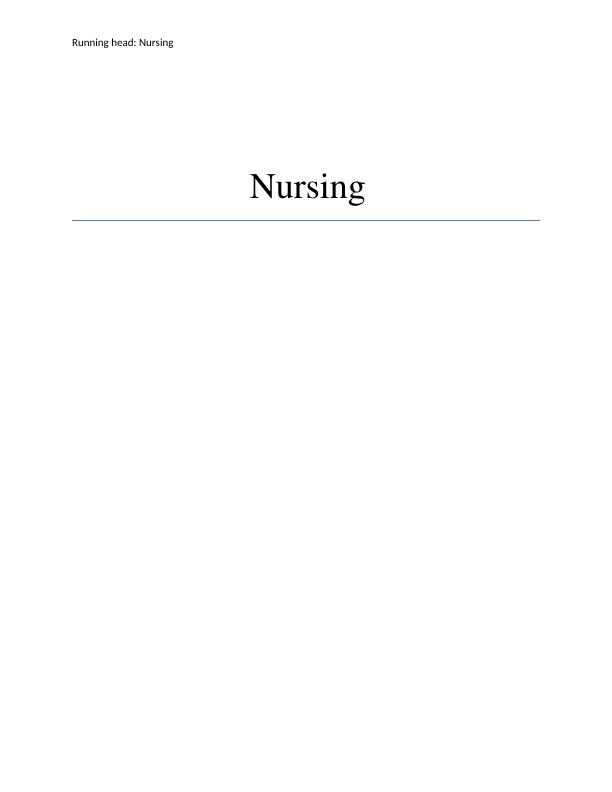
Nursing 1
Contents
Introduction.................................................................................................................................................2
Background.................................................................................................................................................2
Literature search strategy...........................................................................................................................4
Literature review findings............................................................................................................................7
Discussion....................................................................................................................................................9
Conclusion.................................................................................................................................................13
References.................................................................................................................................................14
Appendix A................................................................................................................................................18
Table of Evidence......................................................................................................................................18
Contents
Introduction.................................................................................................................................................2
Background.................................................................................................................................................2
Literature search strategy...........................................................................................................................4
Literature review findings............................................................................................................................7
Discussion....................................................................................................................................................9
Conclusion.................................................................................................................................................13
References.................................................................................................................................................14
Appendix A................................................................................................................................................18
Table of Evidence......................................................................................................................................18

Nursing 2
Introduction
In the opinion of Budden, Birks & Bagley (2017) it has been stated that victimization and
provocation in nursing at the workplace is strictly prohibited. The public health issues can lead
the nurses to experience grave physical and emotional injuries at their workplaces. These can be
anxiety, fatigue, depression and burnout. In Australia, in particular, there have been reports of
bullying and harassment of nurses quantifying to 6.8%.
In this context, employers have a lawful accountability of providing safe workplaces for
their employees. Bullying and incivility at workplace can also be explained as physical, verbal,
psychological and social abuse by the employer or other people at the workplace. It has been
assessed that the Australian economy bears the costs of harassment between 6 and 36 billion
dollars on yearly basis. The persons who bully and victimize the nurses at the workplace can be
other health professionals, patients, their families and nurses (Nemeth et al., 2017).
The factors leading to stressful work environment for nurses can be decreased health funding,
increased accountabilities and bed waiting timings of the beds in the hospitals. Nurses are
susceptible to the impacts of changing health care practices at the workplace and augmented
aggression by the patients and their colleagues. So, in this literature review, various views of
different authors shall be compared, contrasted and evaluated in the light of specific settings in
which they might occur and the factors involved in it.
Background
In the opinion of Ferri et al. (2016) bullying and incivility in nursing is not a new
occurrence and has been previously inserted. It is basically a profession controlled by females
Introduction
In the opinion of Budden, Birks & Bagley (2017) it has been stated that victimization and
provocation in nursing at the workplace is strictly prohibited. The public health issues can lead
the nurses to experience grave physical and emotional injuries at their workplaces. These can be
anxiety, fatigue, depression and burnout. In Australia, in particular, there have been reports of
bullying and harassment of nurses quantifying to 6.8%.
In this context, employers have a lawful accountability of providing safe workplaces for
their employees. Bullying and incivility at workplace can also be explained as physical, verbal,
psychological and social abuse by the employer or other people at the workplace. It has been
assessed that the Australian economy bears the costs of harassment between 6 and 36 billion
dollars on yearly basis. The persons who bully and victimize the nurses at the workplace can be
other health professionals, patients, their families and nurses (Nemeth et al., 2017).
The factors leading to stressful work environment for nurses can be decreased health funding,
increased accountabilities and bed waiting timings of the beds in the hospitals. Nurses are
susceptible to the impacts of changing health care practices at the workplace and augmented
aggression by the patients and their colleagues. So, in this literature review, various views of
different authors shall be compared, contrasted and evaluated in the light of specific settings in
which they might occur and the factors involved in it.
Background
In the opinion of Ferri et al. (2016) bullying and incivility in nursing is not a new
occurrence and has been previously inserted. It is basically a profession controlled by females
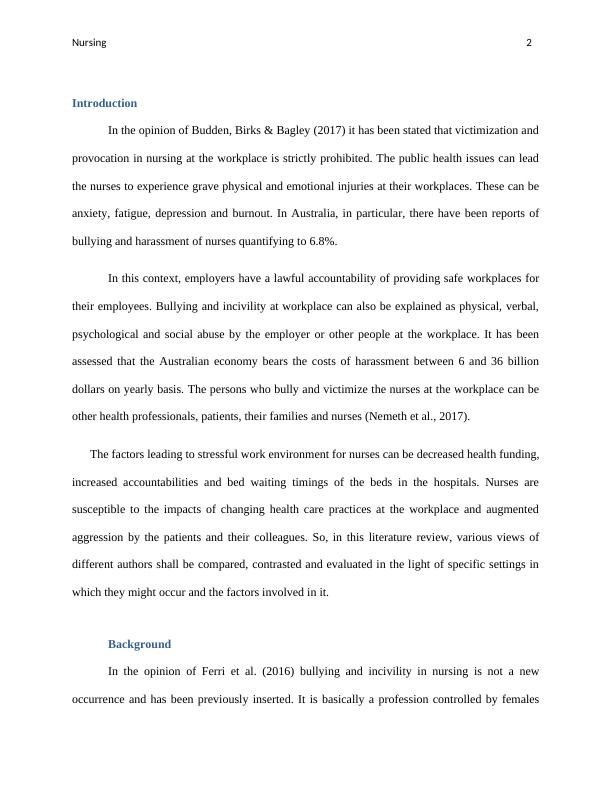
Nursing 3
and it reveals a tradition of bullying by same sex. This bullying behavior has been defined as
‘oppressed group’ behavior which is powered because of low self-esteem and loss of own
individuality in the profession. Though there has been an introduction of changes in the field of
nursing education ,scope of practice and health care, the problem of bullying still continues in
the profession.
The new graduates in the field are weak and are helpless to question their seniors about
the concerned behavior. The violence, incivility and bullying is so much widespread in the
industry that the staff is not concerned about the behavior of their colleagues towards the newly
appointed nurses and they do not support them. Most of the negative behavior experienced at the
workplace is of nonviolent nature. However, there are less incidences of physical and sexual
violence experienced by those who are susceptible to its effects and not stood to defend
themselves in an effective manner.
The negative behaviors have a component of personal elucidation such as being evaluated
or judged in a negative manner. They are often denied of the learning opportunities .Many of the
perpetrators include registered nurses who are at the positions of leaders. Their authority is
reflected in their behavior .It has been observed that the junior or newly appointed nurses are
being bullied by the senior staff. Many of them do not have skills and experience to cope up
with hardships.
This socio demographic profile makes the scholars more susceptible when they are
challenged with behaviors which are intolerable. In this regard, it is expected by the clinical
facilitators that they shall advocate, safeguard, mentor and become a role model of the amateur
nurses . But on the contrary, they themselves are involved in bullying and harassing the nurses. It
and it reveals a tradition of bullying by same sex. This bullying behavior has been defined as
‘oppressed group’ behavior which is powered because of low self-esteem and loss of own
individuality in the profession. Though there has been an introduction of changes in the field of
nursing education ,scope of practice and health care, the problem of bullying still continues in
the profession.
The new graduates in the field are weak and are helpless to question their seniors about
the concerned behavior. The violence, incivility and bullying is so much widespread in the
industry that the staff is not concerned about the behavior of their colleagues towards the newly
appointed nurses and they do not support them. Most of the negative behavior experienced at the
workplace is of nonviolent nature. However, there are less incidences of physical and sexual
violence experienced by those who are susceptible to its effects and not stood to defend
themselves in an effective manner.
The negative behaviors have a component of personal elucidation such as being evaluated
or judged in a negative manner. They are often denied of the learning opportunities .Many of the
perpetrators include registered nurses who are at the positions of leaders. Their authority is
reflected in their behavior .It has been observed that the junior or newly appointed nurses are
being bullied by the senior staff. Many of them do not have skills and experience to cope up
with hardships.
This socio demographic profile makes the scholars more susceptible when they are
challenged with behaviors which are intolerable. In this regard, it is expected by the clinical
facilitators that they shall advocate, safeguard, mentor and become a role model of the amateur
nurses . But on the contrary, they themselves are involved in bullying and harassing the nurses. It
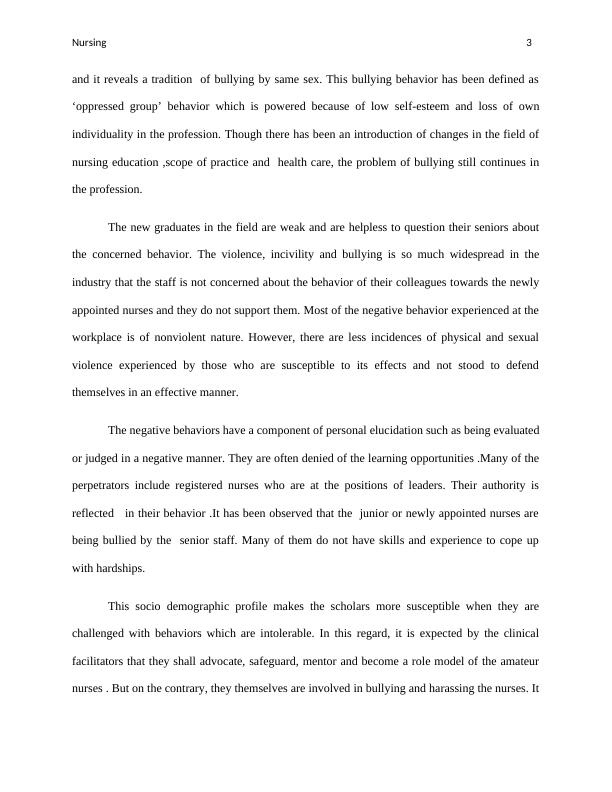
Nursing 4
raises a serious question about the methods in which these organizers are selected, supervised,
evaluated and prepared in the clinical workplaces.
Birks et al.,(2017) said that it is due to the reason of variations in health care and funding
of education and increased number of students have led to the loosing of control over the off
campus learning experiences students . In some of the cases, it has been observed that
universities pay for providing health services to the nurses so that they can play the role of
clinical facilitators but they often lack commitment and loyalties and play dual roles.
The amateur nurses do not compliant against them as they are scared about the negative
reactions of the staff. It has also been reported that some of them consider civility as a part of the
job and contemplate such incidents to be too insignificant to be reported. In this scenario there
are many bystanders who are eager to know the consequences of whistle blowing on their
colleagues in clinical setups which are risk averse and have proper procedures in place to deal
with the same but often are unwilling to tackle such problems as and when they arise.
Allen, Holland & Reynolds (2015) contradicted the point by saying that the exposure to
practices of bullying and harassment are considered to be a major cause of health problems for
the sufferers. Apart from losses borne by the nurses, they have an adverse effect on the safety of
the patients, quality of care and long term issues confronted by the profession as a whole. So, the
economic impact of incivility and bullying on the workforce cannot be estimated. This reflects
the complexity of the problem. It requires a multifaceted solution.
Literature search strategy
This search strategy of this literature review aims to find that incivility, violence and
bullying at the workplace are some of the issues in nursing which can lead to serious
raises a serious question about the methods in which these organizers are selected, supervised,
evaluated and prepared in the clinical workplaces.
Birks et al.,(2017) said that it is due to the reason of variations in health care and funding
of education and increased number of students have led to the loosing of control over the off
campus learning experiences students . In some of the cases, it has been observed that
universities pay for providing health services to the nurses so that they can play the role of
clinical facilitators but they often lack commitment and loyalties and play dual roles.
The amateur nurses do not compliant against them as they are scared about the negative
reactions of the staff. It has also been reported that some of them consider civility as a part of the
job and contemplate such incidents to be too insignificant to be reported. In this scenario there
are many bystanders who are eager to know the consequences of whistle blowing on their
colleagues in clinical setups which are risk averse and have proper procedures in place to deal
with the same but often are unwilling to tackle such problems as and when they arise.
Allen, Holland & Reynolds (2015) contradicted the point by saying that the exposure to
practices of bullying and harassment are considered to be a major cause of health problems for
the sufferers. Apart from losses borne by the nurses, they have an adverse effect on the safety of
the patients, quality of care and long term issues confronted by the profession as a whole. So, the
economic impact of incivility and bullying on the workforce cannot be estimated. This reflects
the complexity of the problem. It requires a multifaceted solution.
Literature search strategy
This search strategy of this literature review aims to find that incivility, violence and
bullying at the workplace are some of the issues in nursing which can lead to serious
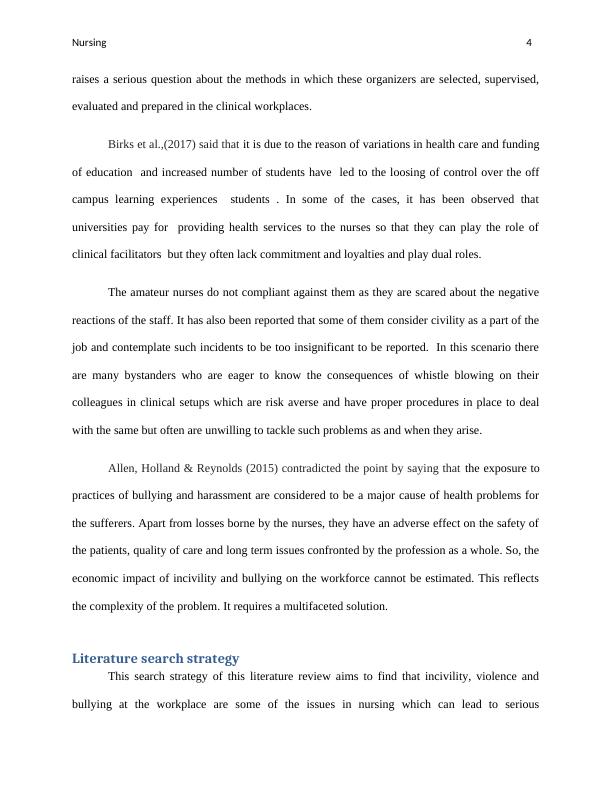
Nursing 5
consequences for all the stakeholders. Incivility is amongst the most rude, impolite and ill-
mannered actions which may or may not have an undesirable intention behind them. Bullying is
harmful, unwanted and repeated actions are intended to humiliate, cause distress and offend the
receiver. Some of the activities of aggression are completely unacceptable and they comprise of
verbal and physical abuse. They can be delivered by colleagues or patients of the nurses as well.
These occurrences may have a serious impact not only on the wellbeing of the nurses but also on
their capability to care for the patients (Rush et al.,2014).
Vogelpohl et al., (2013) contradicted the pint by saying that incivility and bullying
includes violence namely patients with whom the nurses interact during their regular course of
duties. It is one of the most common health care assaults which is based on the work place
environment. Another is done with the intention of criminal intent in which the violence is
carried out in association with crime. The third type of work related violence comprises of
bullying in health care in which the culprit and victim work together . In this case, it is not
necessary that both are in the same role or at similar levels. The last type of violence takes place
when the victim is targeted due to the existing relationship with the wrongdoer along with the
violence taking place at the work place.
On the contrary, Lachman (2014) suggests that it is a violation of the Code of Ethics .As
per his opinion; disruptive behaviors can raise medical errors and contribute to the poor
satisfaction of the patients. It instigates opposing consequences and intensifies the cost of care
and encourages the qualified clinicians, managers and administrators to pursue new positions in
more specialized surroundings. With the emergence of Medicare reimbursements for health care,
the issues of cost , satisfaction of patients and their safety , they even become more important to
consequences for all the stakeholders. Incivility is amongst the most rude, impolite and ill-
mannered actions which may or may not have an undesirable intention behind them. Bullying is
harmful, unwanted and repeated actions are intended to humiliate, cause distress and offend the
receiver. Some of the activities of aggression are completely unacceptable and they comprise of
verbal and physical abuse. They can be delivered by colleagues or patients of the nurses as well.
These occurrences may have a serious impact not only on the wellbeing of the nurses but also on
their capability to care for the patients (Rush et al.,2014).
Vogelpohl et al., (2013) contradicted the pint by saying that incivility and bullying
includes violence namely patients with whom the nurses interact during their regular course of
duties. It is one of the most common health care assaults which is based on the work place
environment. Another is done with the intention of criminal intent in which the violence is
carried out in association with crime. The third type of work related violence comprises of
bullying in health care in which the culprit and victim work together . In this case, it is not
necessary that both are in the same role or at similar levels. The last type of violence takes place
when the victim is targeted due to the existing relationship with the wrongdoer along with the
violence taking place at the work place.
On the contrary, Lachman (2014) suggests that it is a violation of the Code of Ethics .As
per his opinion; disruptive behaviors can raise medical errors and contribute to the poor
satisfaction of the patients. It instigates opposing consequences and intensifies the cost of care
and encourages the qualified clinicians, managers and administrators to pursue new positions in
more specialized surroundings. With the emergence of Medicare reimbursements for health care,
the issues of cost , satisfaction of patients and their safety , they even become more important to
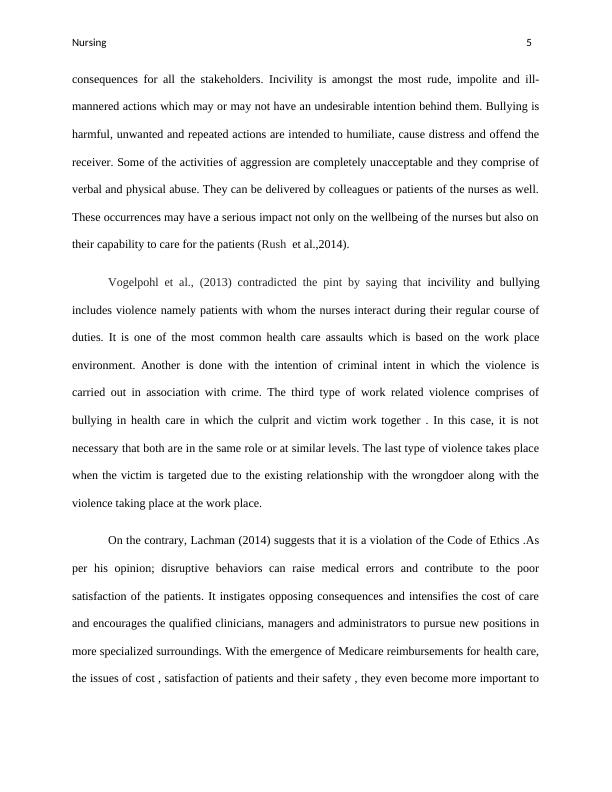
End of preview
Want to access all the pages? Upload your documents or become a member.
Related Documents
Incivility in Nursing: Creating a Healthy Work Environmentlg...
|7
|1665
|488
Strategies for Overcoming Incivility and Bullying in Nursing Professionlg...
|36
|5179
|90
Nursing Assignment Workplace Bullyinglg...
|8
|2207
|171
Nurse Bullying Answer 2022lg...
|7
|1968
|9
Bullying in the Workplace | Nursinglg...
|16
|3705
|18
Cultivating Healthful Environment Assignmentlg...
|6
|1539
|227
